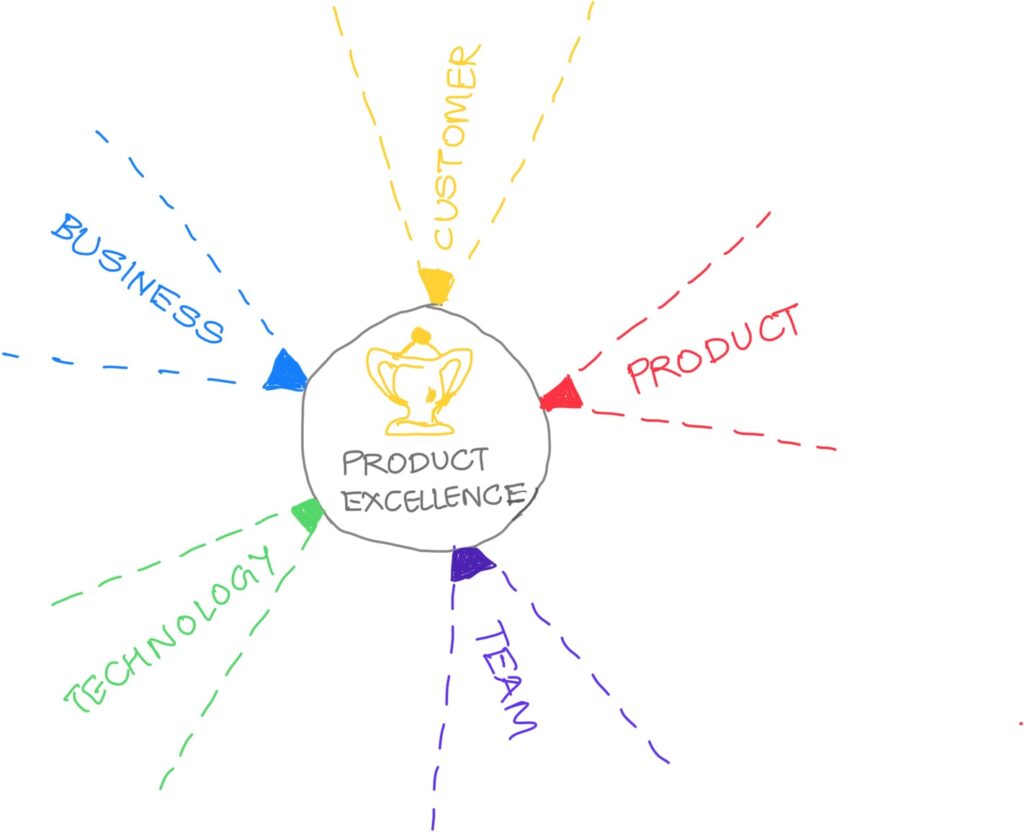One of the core pillars of my “PURCLATION” principle is EXECUTION: a leader’s data-driven ability to execute. A popular saying goes … Strategy without execution is hallucination. Allow me to kick it up a notch … Execution without KPIs is delusion. So, let’s focus on how a product leader can harness the power of KPIs to drive product and team success.
Broadly, product KPIs break down into 5 key categories as illustrated below and product success lies at their confluence. I’ll quickly touch upon these frameworks:

Customer: The best framework I’ve seen to track customer success is Google’s HEART. It measures end-to-end customer well-being through CSAT, adoption, engagement, retention and usability. Upleveling it, NPS measures customer perception of your company and it’s products, collectively speaking.
Business: This is the broadest KPI category and is contoured to company needs. Essentially, it boils down to Financial (P&L, CAC, LTV, Subscription growth, etc.), Operational (OpEx, CapEx, Support, SLAs, etc.) and Sales (Close Ratio, ACV, etc.) KPIs.
Product: Somewhat overlapping customer metrics, leaders should continuously measure product relevance. This involves adoption (penetration, segmentation, etc.) and usage (MAU, DAU, etc.). Periodically, leaders should measure product-market fit using Sean Ellis’ survey. Finally, they should keep a close eye on the product funnel and leaks using pirate metrics – AAARRR!
Technology: Ain’t no good product with no good technology powering it. TechOps metrics such as app performance, API performance, Crashes, latency, etc are of particular importance. APM tools are great way of tracking TechOps metrics.
Team: Healthy teams power healthy products. Metrics such a velocity, burndown, team CSAT, etc. help determine team success.
So, how can a leader utilize these metrics pillars to drive product success across entire lifecycle – from development to launch to success? Few techniques to add to your tool chest:
Build a watch tower:
- Invest in building a dashboard that tracks metrics with clearly marked categories and whether they are lagging/leading edge or primary/secondary.
- Identify top 5 success metrics for your product that the team, stakeholders and executives have aligned on. These become part of your product gospel, whether it’s an executive readout or kicking off a morning scrum.
- Hire smart business analysts or SQL/Tableau ninjas that can dig up anomalies or correlations in data sets to help understand cause-effect relationships. Identifying root causes will empower you to fix the symptoms.
Refine your strategic focus: A well-built watch tower will expose trends, wins and loses.
- Wins will allow you to focus your resources, time and energy on what’s working and loses to either critically improve or avoid.
- Trends will help you identify the trajectory of customer behavior, product usage, and shed light on new opportunities.
Collectively and combined with secondary research, these priorities will help you refine your immediate focus or define your next-generation vision and strategies for years to come. A simple prioritization table below helps:
| KPI | Description | Category | Baseline | Goal | Trend |
| A | CSAT | Customer | 4 | 4.5 | + 5% |
| B | Adoption | Product | 60% | 75% | – 10% |
| C | LTV | Business | $50K | $70K | -15% |
Management by Objective:
- True to this principle, ensure that all product teams – PM, PMO, Engineering, Services, etc. – are all collectively measured using business outcomes rather than vanity metrics such as code completion or number of releases.
- Be ready to respond to rapidly changing customer and business needs. Use the truth behind the watch tower to negotiate short-term roadmaps (say a pivot due to pandemic) or alter your 2-3yr vision to align with the new trends uncovered.
Balance watchtower with gut calls and blue-sky: Strike a delicate balancing act between data-driven truth and blue-sky thinking when it comes to crafting future strategy. Open your business case with identifying wins, loses, trends and opportunities while offering a healthy dose of aspirational goals that exercise innovation muscle. If you don’t have sufficient data or metrics are not sufficiently tracked, bring your acute product sense to make gutsy calls – a simple 80:20 rule can be applied here – if you have < 80% confidence in your data, take a well-articulated gut call.
Proficient leaders use data and KPIs as their sword to strike strategy and execution and their shield to protect products and teams from fleeting assumptions. Use KPIs and become one!

I like reading through a post that will make people think. Also, thanks for allowing me to comment. Lucille Kev Ruperto